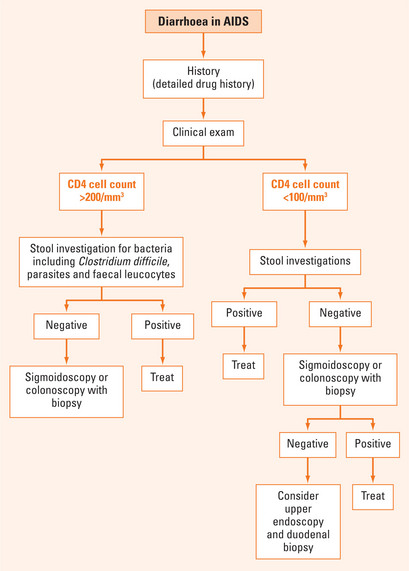Chapter 22 HIV/AIDS
GASTROINTESTINAL AND LIVER MANIFESTATIONS
INTRODUCTION
Clinical advances have evolved in consonance with a greater understanding of the virologic and immunologic markers of disease stage, mechanisms of viral transmission and the problem of viral resistance to antiretroviral drugs. Gastrointestinal and hepatobiliary complications are important components of the HIV/AIDS syndrome. They are common and affect most patients with AIDS during the course of their illness.
CHRONIC DIARRHOEA
Because of the wide spectrum of potential infections that may cause diarrhoea (Table 22.1), it is appropriate to have a systematic approach in investigating the aetiologic agent/s (Figure 22.1; Table 22.2). Weight loss and diarrhoea suggest an opportunistic infection, malabsorption or small bowel bacterial overgrowth. Severe watery diarrhoea suggests cryptosporidiosis. Diarrhoea with nausea and abdominal pain may indicate Giardia, Isospora belli or Mycobacterium avium. Rectal bleeding may indicate viral or bacterial colitis or Kaposi’s sarcoma.
TABLE 22.1 Common causes of diarrhoea in AIDS
| Protozoa | Microsporidium; Cryptosporidium; Isospora belli, Giardia lamblia, Blastocystis hominis; Pneumocystis carinii; Entamoeba histolytica |
| Bacteria | Mycobacterium tuberculosis; Mycobacterium avium complex (MAC); Clostridium difficile; Salmonella, Shigella, Campylobacter |
| Viruses | Cytomegalovirus; herpes simplex; adenovirus; rotavirus |
| Fungi | Candidiasis; Cryptococcus; Histoplasmosis; Coccidioidomycosis |
| Neoplasms | Lymphoma, Kaposi’s sarcoma |
| Drug-induced | HIV protease inhibitors |
| Idiopathic | AIDS enteropathy |
| Pancreatic disease | Pancreatitis; infectious pancreatitis; drug-induced pancreatitis |

FIGURE 22.1 Assessment of diarrhoea in AIDS.
Based on Wilcox CM. AIDS and the gut. In: Weinstein WM, Hawkey CJ, Bosch J, eds. Clinical gastroenterology and hepatology. Philadelphia: Mosby; 2005:8331–6, with permission.
TABLE 22.2 Assessment of diarrhoea in AIDS
Stay updated, free articles. Join our Telegram channel
Full access? Get Clinical Tree
 Get Clinical Tree app for offline access
Get Clinical Tree app for offline access

|





